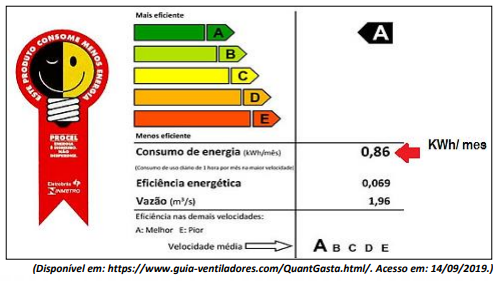Questões de Vestibular FIMCA 2019 para Vestibular de Medicina - Edital nº 01/ 2020
Foram encontradas 60 questões
“A corrente elétrica é o fluxo ordenado de cargas elétricas, que se movem de forma orientada em um condutor elétrico sólido ou em soluções iônicas.”
“Esse fenômeno ocorre devido ao encontro dos elétrons da corrente elétrica com as partículas do condutor. Os elétrons sofrem colisões com átomos do condutor; parte da energia cinética (energia de movimento) do elétron é transferida para o átomo aumentando seu estado de agitação, consequentemente a sua temperatura.”
Considerando os trechos anteriores podemos afirmar que a transformação de energia elétrica em energia cinética é conhecido por:
Sistema de geração de energia tem registrado recordes de consumo, principalmente no horário de calor mais intenso, entre as 14h e as 17h.
(22/01/2019 22h32. Atualizado há 7 meses.)
Suadeira agora só na hora de pagar a conta de luz. A despesa com energia elétrica mais que dobrou. De cara, o especialista identificou um problema: o ar-condicionado é daqueles que consomem mais energia. “No caso aqui, você comprou um equipamento classificado como C. Ele consome mais energia. O A é o mais eficiente, chega a ser quase 30% mais eficiente do que este classificado como C. Então, quando você compra o equipamento talvez um pouco mais barato, ao longo do tempo de uso, você vai pagando essa diferença. Acaba ficando bem mais caro. É o barato que sai caro”, explicou o especialista da Cemig. E tem muito mais coisa para ajudar o bolso: usar o chuveiro na posição desligado; trocar lâmpadas por modelos de led, mais eficientes; verificar se a borracha da geladeira está vedando adequadamente. Uma dica é fazer o teste da folha de papel na porta. Se ela não ficar presa, está na hora de trocar o isolamento.
(Disponível em:https://g1.globo.com/jornal-nacional/noticia/2019/01/22/brasil-atinge-maior-nivel-de-producao-de-energia-eletrica-em-20-anos. ghtml/. Acesso em: 14/09/2019.)
Se o ar-condicionado de uma casa apresentar a tarjeta abaixo e potência de 1.400 W, qual será o consumo mensal, se ele ficar funcionando 9 horas por dia durante 20 dias?




Considerando a reação entre o gás carbônico e a água dentro dos vegetais tem-se a produção de glicose e gás oxigênio.
Indique a quantidade do volume molar, em L, de glicose ao ser produzido 6 mols de gás oxigênio, tendo o volume molar igual a 22,4 L.
Considerando a reação entre o gás carbônico e a água dentro dos vegetais tem-se a produção de glicose e gás oxigênio.
Reagindo 154 g de gás carbônico com 72 g de água, espera-se a formação de 96 g de gás oxigênio. Assinale a alternativa que compromete tal afirmação.